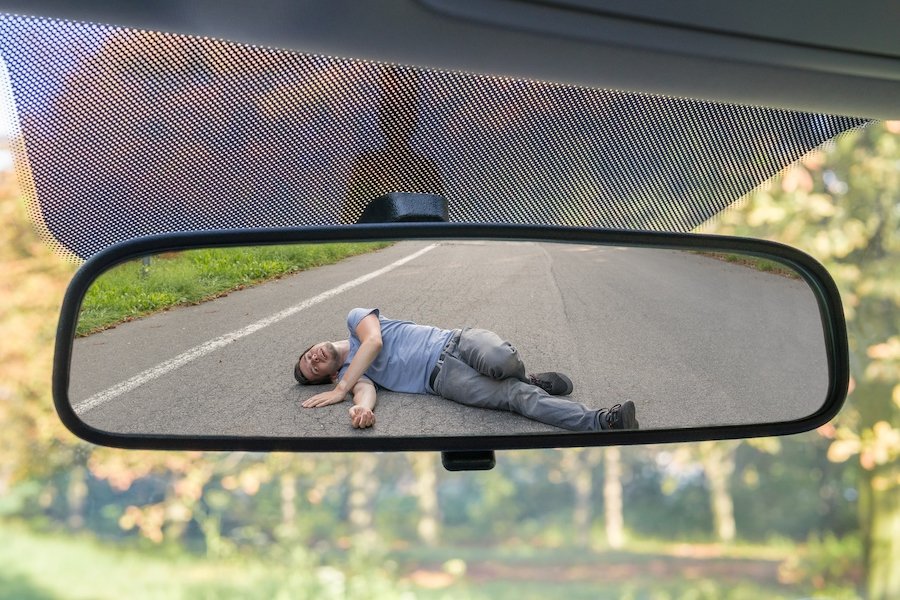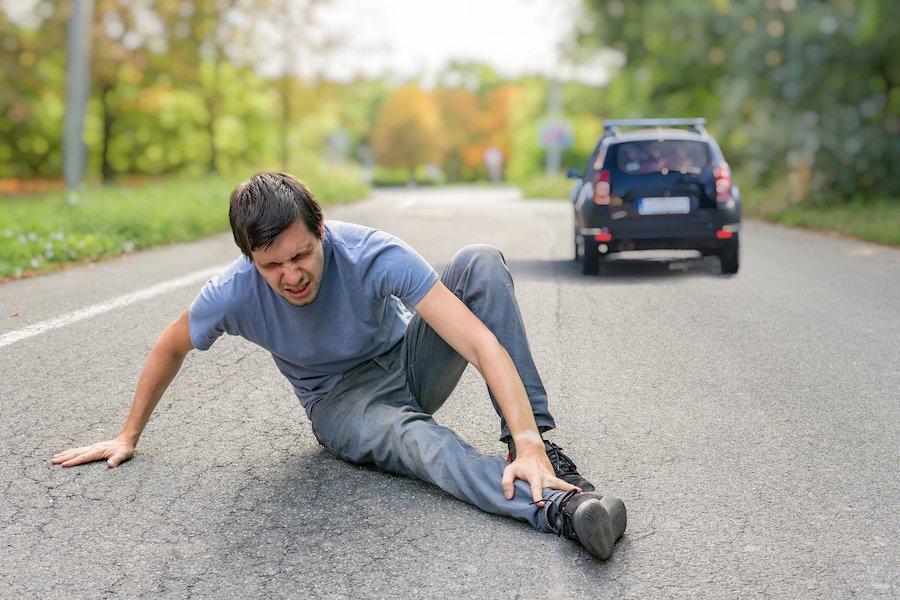If you are involved in a motor vehicle accident in Nevada, NRS 484E.030 requires that you:
- stop at the scene,
- provide your name, registration, and address to the other parties, and
- render assistance to anyone who is injured.
Otherwise, you risk being arrested for hit and run. This chart illustrates the penalties for fleeing the scene of an accident:
| Hit & Run Charge |
Criminal Sentence |
| Causing only property damage | misdemeanor – up to 6 months in jail and/or $1,000 in fines. |
| Causing an injury or death | category B felony – 2 to 20 years in prison and $2,000 to $5,000 in fines. |
In this article, our Las Vegas criminal defense attorneys discuss:
- 1. What is considered hit and run in Las Vegas?
- 2. What happens if you leave the scene of an accident in Nevada?
- 3. How do I fight hit and run charges in Las Vegas?
- 4. When can my criminal record be sealed?
- 5. How long after a hit-and-run accident can you be charged in Nevada?
- 6. Can the victim of a hit-and-run file a lawsuit?
- 7. Additional resources
1. What is considered hit and run in Las Vegas?
Under Nevada law, hit and run is when you hit another car and drive off without first rendering aid (if necessary) and exchanging vehicle and contact information.
What do I have to do after a car accident?
Following a Las Vegas car accident or other car crash in Nevada, you should immediately stop at the scene of the accident whether or not you were the one at fault. If your vehicle is creating a hazard or blocking traffic, you should move your vehicle to a safe location if possible.
State law then requires you to:
- Provide your name, address, and vehicle registration number to the other driver(s) involved. Upon request, you should also show your driver’s license; and
- Provide your name, address, vehicle registration number, and licenses to any police at the scene; and
- Render aid to any injured people needing medical attention. Examples include carrying them to safety and/or calling an ambulance. (If the driver cannot call 911 because of injury, a passenger should call.)1
If you hit unattended property in Nevada – such as a parked car or a fence – then you must immediately stop and try to find the property owner. Failing that, you must then leave a conspicuous note with
- your name,
- the vehicle owner’s name (if you do not own the car), and
- your address.2
Gather evidence
After a crash, it is also a good idea to get the contact information of any eyewitnesses. They may be able to testify on your behalf if you are charged and/or sued.
Also be sure to take photographs of the scene, property damage, and physical injuries. Then, write down all the details you can remember, including road and weather conditions. All this information can help you in court.
When do I have to notify the police of an accident?
Nevada law enforcement, such as the Metro Las Vegas police (LVMPD) must be notified about any car accident that results in either
- death,
- bodily injury, or
- property damage of $750 or more.
If the police arrive at the scene of the accident and file an accident report themselves, then you do not have to file a report as well. Though if police officers are not present at the crash, then you have 10 days from the date of the accident to submit a Nevada DMV SR-1 accident report.3
If a car accident in Nevada leaves you physically incapable of making a report, you do not have to file one until you regain capacity. If you do not own the car – and you are incapacitated – then the owner is required to file the report within 10 days after becoming aware of the accident.4
Nevada penalties for failing to make an accident report
- Willfully failing to make an accident report if necessary results in a license suspension of up to one year, and
- Submitting a false report is a gross misdemeanor, carrying up to 364 days in jail and/or up to $2,000 in fines.5

Nevada hit and run accident victims should try to record the at-fault driver’s license plate number before they flee.
2. What happens if you leave the scene of an accident in Nevada?
If there is only property damage
Leaving the scene of an accident resulting in only property damage is a misdemeanor in Nevada. The sentence is:
- Up to 6 months in jail, and/or
- Up to $1,000 in fines6
In addition, the DMV adds six demerit points to your driver’s license. If you accrue 12 or more points in a year, the DMV will impose a six-month license suspension.7
If there are injuries or death
Leaving the scene of an accident resulting in bodily injury or death is a category B felony in Nevada.
The sentence is:
- 2 to 20 years in Nevada State Prison, and
- $2,000 to $5,000 in fines, and
- A driver’s license revocation
You face separate hit-and-run charges for every person injured or killed in one accident. Plus the court may not suspend the prison sentence or grant probation.8
We have seen cases where the driver opted not to call 911 right away because the other parties involved did not appear injured, but it turns out they were. In fact, the delay in receiving medical care caused their injuries to be much worse than they might have otherwise.
As a result, the driver faced a felony charge for hit and run with injury. In addition, the driver’s choice not to call 911 in a timely manner was used against the driver in the ensuing personal injury case.
3. How do I fight hit and run charges in Las Vegas?
Here at Las Vegas Defense Group, we have represented literally thousands of people charged with hit and run. In our experience, the following defenses have proven very effective with prosecutors, judges, and juries:
- You were not involved in the accident and therefore had no duties to stop. Crash scenes are very frenetic, so it is not uncommon for people who were near the collision to be mistakenly identified as one of the participants. In these situations, we rely on traffic surveillance video, GPS records, and eyewitness accounts to clear our clients from criminal liability.
- You did not know you were involved in an accident. If you grazed another car without realizing it, we can try explaining to the prosecutor that any reasonable driver in your position also might have not noticed the contact. Or perhaps you were having a medical episode at the time and genuinely did not realize you made contact with another vehicle; here, we would use your medical records and expert medical testimony to show the D.A. that you were unable to process what was happening and did not knowingly leave the crash scene.9
- You sufficiently fulfilled all the legal obligations of exchanging information and rendering aid. We have had clients who did everything right (exchanging information, rendering aid, etc.) but were still falsely charged with hit and run. Here, we compile all the available evidence (such as police bodycam footage) to illustrate you followed all the rules.
- You were too incapacitated after the accident to stop, exchange information, or render aid. This is another defense where we rely on our clients’ medical records to show that no reasonable person in their position would have been capable of exchanging information and rendering aid.10

A hit-and-run is failing to stop at an accident that caused injury, death, or property damage.
4. When can my criminal record be sealed?
- Felony hit-and-run convictions may be sealed in Nevada five years after the case ends.
- Misdemeanor hit-and-run convictions may be sealed one year after the case ends.
- If the charges get dismissed, then there is no wait before you can petition for a record seal.11
Learn how to seal Nevada criminal records.
5. How long after a hit-and-run accident can you be charged in Nevada?
Nevada prosecutors have
- one year to bring misdemeanor hit-and-run charges and
- three years to bring felony hit-and-run charges.12
Learn more about criminal statutes of limitations in Nevada.
6. Can the victim of a hit-and-run file a lawsuit?
Yes. Nevada car accident victims may file personal injury lawsuits against the alleged hit-and-run driver. In these cases, victims typically sue the driver (“defendant”) for negligence per se.13
If successful, the victim’s car accident attorneys may be able to recover financial compensation to cover all their:
- medical expenses,
- lost wages,
- loss of future earnings,
- pain and suffering, and/or
- loss of support (in wrongful death cases)
In some hit-and-run cases, the police department can never locate the car driver who fled the motor vehicle accident. Even if they do, the driver may be an uninsured motorist.
That is why accident lawyers advise everyone to carry uninsured / underinsured motorist coverage (UM/UIM). As long as the insured was not the one at fault, the UM/UIM car insurance company can pay out any compensatory damages within the policy limits.
7. Additional Reading
- Crash Report Request, Nevada DMV
- Understanding Auto Insurance, Nevada Department of Insurance
- Vehicle Accident Procedures, Nevada Department of Administration Risk Management
Legal References
- NRS 484E.010; NRS 484E.020; NRS 484E.030. (See the Nevada car accident statutes.)
- NRS 484E.040.
- NRS 484E.050; NRS 484E.060; NRS 484E.070.
- Same.
- NRS 484E.080.
- NRS 484A.900.
- NAC 483.510; NRS 483.448.
- NRS 484E.010; see also Sabrina Schnur, Fatal hit-and-runs spike in Las Vegas in 2021, Las Vegas Review-Journal (May 7, 2021).
- Clancy v. State, (2013) 129 Nev. 840, 313 P.3d 226, 129 Nev. Adv. Rep. 89.
- See also Smith v. State (2020) 468 P.3d 375; Hodges v. State (2019) 439 P.3d 957. See also Chadwick v. State (2024) 140 Nev. Adv. Op. 10 (“Nevada’s appellate courts have not previously addressed the admissibility of evidence of a defendant’s alcohol consumption and apparent intoxication while driving in cases where the defendant is charged with
leaving the scene of an accident in violation of NRS 484E.010. We conclude that the district court did not abuse its discretion by admitting this evidence because it was relevant to Chadwick’s motive to flee, proven by clear and convincing evidence, and not unfairly prejudicial.”) - NRS 179.245; NRS 179.255.
- NRS 171.085. NRS 171.090.
- Barnes v. Delta Lines, Inc, (1983) 99 Nev. 688; Nevada Jury Instructions 4.12. In order to prevail on a negligence per se claim, the victim (“plaintiff”) would need to prove that: 1) There is a statute (the hit-and-run laws) that exists to protect a class of persons; 2) The plaintiff was a member of that class (a fellow motorist, car occupant, pedestrian, cyclist, etc.); 3) The defendant violated the law or statute (by not stopping at the crash site); and 4) The defendant’s violation of the law proximately caused the plaintiff’s injuries or damage.

